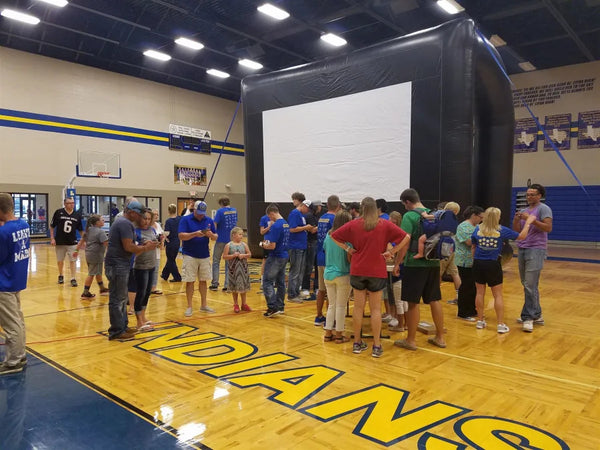Sealed vs. breathing inflatable outdoor movie screens
There are two types of inflatable movie screens that you can get: sealed (welded) vinyl screens and breathing inflatable screens made of vinyl or nylon or other textile blends.
While there is one huge advantage to the sealed screens the rest of the specs for this type of inflatable screens have drawbacks when compared to the breathable type.
The main advantage of sealed inflatable movie screens
Sealed screens don't need an air blower to stay inflated during the screening. When you want to use your sealed screen you just inflate it with an air pump or air blower and seal it with a valve.
Sealed screens are a favorite when it comes to indoor screenings or silent movie events.

Drawbacks of the sealed screens
The main drawbacks of the sealed screens are as follows:
- Heavy weight.
- Puncture vulnerability.
- High cost of production and the subsequent high cost.
- Shorter lifespan.
- Low weather resistance which results in seams leaking air after several years of continuous use. Most vinyl blends are sensitive to freezing temperatures and may crack.
Why are the breathable inflatable movie screens better than the sealed ones?
The sealed screens are made of vinyl that is heavier than that used in breathing screens because any tiny puncture can deflate a sealed screen during your open air show.
It is impossible to produce a wholesome piece of vinyl -- let's say 16' x 9' -- so the sealed screens are made of a bunch of vinyl pieces welded together. Each such seal is a potential leakage point, especially the parts of the sealed screen that normally end up being folded.
Breathing screens typically are made of lighter fabric. A 20' x 11' breathable screen can be carried by one adult and easily fits into a sedan trunk. When a breathing screen is inflated to maintain its shape throughout the whole duration of your movie under stars event you will need to constantly run the air blower.

Note that the air blowers that come with the screen kits and systems that Big Screen Pro offers can run up to 10 hours uninterrupted.
Breathing screens are not afraid of punctures and the seams of this type of inflatable screens are not sealed. We know of some customers whose breathing screens have served them for something like 15 years without needing to patch or repair them.
Read this article about reasons why the sealed inflatable screen is not always the best option.
Sealed Vs Breathing inflatable movie screens - a quick comparison
Sealed screens
- Do not need air blower to stay inflated
- No air blower noise
- Can float as in poolside movie parties
- More expensive
- Heavier and bulkier to transport
- Puncture-prone
- May need repair and patching after several years of continuous use
- More affordable
- Weigh less and are smaller in size both when stored and transported
- Maintenance-free, much longer lifespan
- Requiring air blower to stay inflated (shop for a sound dampening blower box to reduce air blower noise)
Conclusion
According to the above, if you don't plan to have many indoor screenings or if you don't need your outdoor movie screen to stay inflated for days in a row, the breathing inflatable screen is the best option for you.
RELATED ARTICLES
5 Outdoor movie night essentials - Simple guide for beginners
